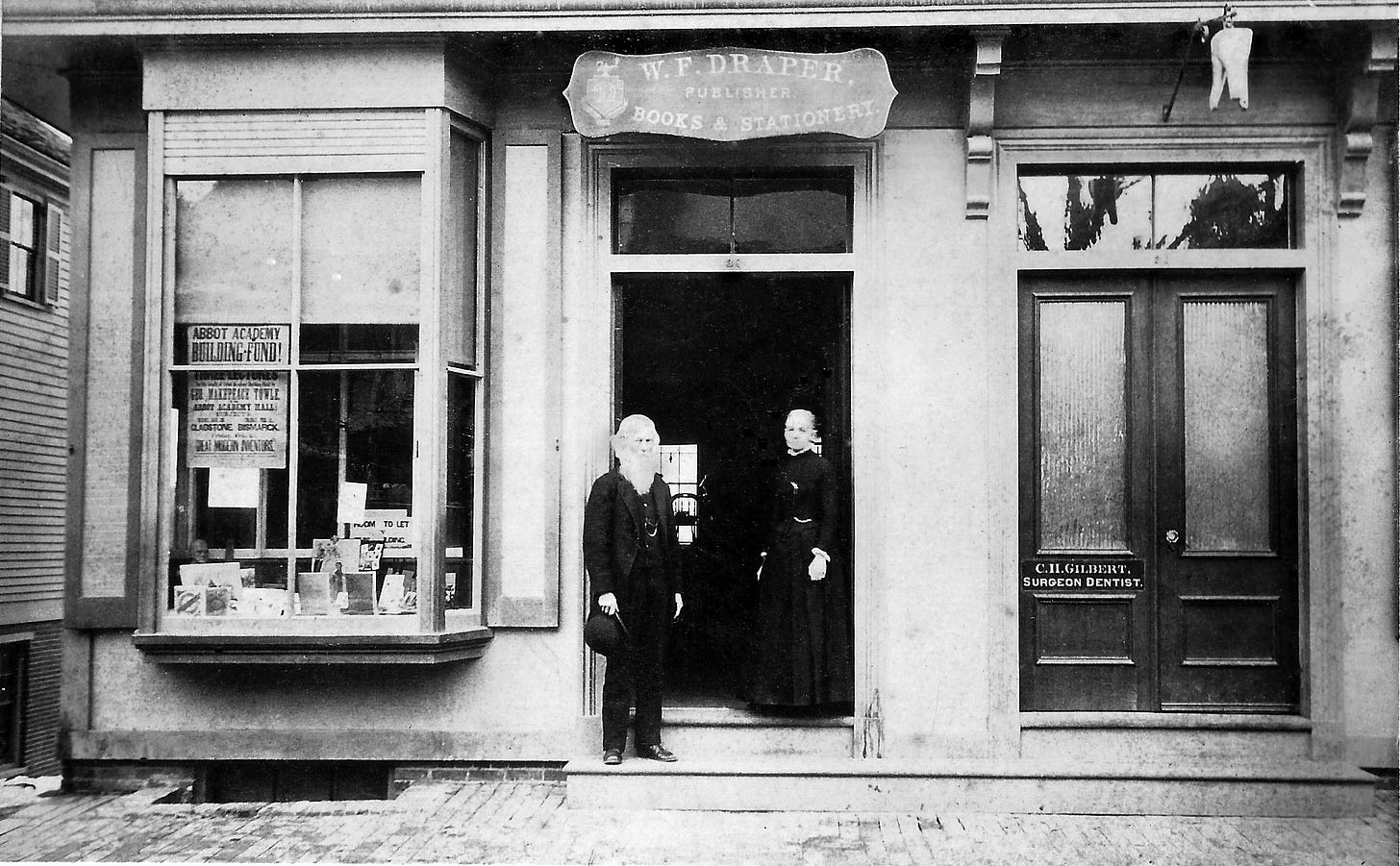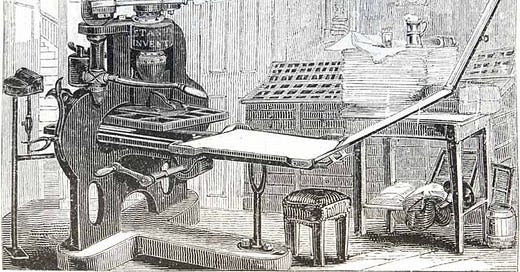"We anticipate the coming of your Paper as a welcome family visitor…."
The Andover Advertiser and rural newspapers, part 1
Help spread the word about History Buzz by liking, commenting, sharing, and subscribing. Your paid subscription helps support the research and writing that makes History Buzz possible. You can help share the Buzz!
We use historic newspapers frequently in our research, so I thought I’d take a look at the first issue of the Andover Advertiser, published Saturday, February 19, 1853.1
The first issue of the Advertiser bears all the features of a rural or small-town newspaper in the mid-1800s. Over the next few weeks, I’ll share stories from the paper’s first issue.
But first, some background...
Printing in Andover
Andover Theological Seminary and Phillips Academy, founded in 1778, were central to the printing industry in Andover. It was here that religious tracts, sermons, Bibles, and books were published and distributed through Orthodox Calvinist missionaries around the world.
The earliest print shop in Andover dates back to 1798.
The Andover Press printed books in Armenian, Arabic, Greek, German, Hebrew, and many more Asian and Native American languages. Textbooks and other school supplies for Phillips Academy students were also published here.2
“Printers Row” or “Book Row” were local nicknames for the row of houses where Andover’s printers lived, near the print shops where the writing, type-setting, printing, and binding of books took place. Andover printers Timothy Flagg, Abraham Gould, Warren Draper, Mark Newman, and Jonathan Leavitt lived and worked on Printers Row.3
Urban and Rural Newspapers
The newspaper industry grew as the United States grew, fueled by an increase in literacy rates, leisure time, and political activity by the working and middle classes that came with the industrial revolution. In 1800, there were 200 newspapers published in the country. By 1860, that number had grown to 3,000.4
Included among those 3,000 newspapers was the Andover Advertiser, founded in 1853 by bookseller and publisher Warren F. Draper.

The first issue of the Andover Advertiser followed trends for local or country newspapers. It was published in a large format, 22” by 27,” with evenly spaced columns that run the entire length of the page.
Outside advertisements, there is very little that breaks up the block of text and the very small font used.
Rural newspapers printed fiction, poetry, bits of wisdom, and clever anecdotes.
Small town newspapers typically didn’t cover a lot of local news. For news – because the editor was also the reporter, writer, advertising sales head, typesetter, printer, and distributor – editors filled their papers with stories culled from “big city” newspapers the editors received by exchange.5
The US government encouraged expansion of the newspaper industry by waiving postal fees for exchanges of newspapers between printers.
Urban newspapers were partisan ventures, connected directly with political parties. With names like The Washington Democrat and the Chicago Republican, their political connection was obvious.6
Andover Advertiser
The Andover Advertiser took a different, decidedly nonpartisan, approach. The paper’s tagline, “The Life of Agriculture, Trade, and Commerce, Is A Good Advertising Medium,” makes its intended purpose clear.
On page 2 of the first issue, in a rather testy tone, editor Warren Draper outlined his intent,
In presenting this sheet to the citizens of Andover and vicinity, the publisher would observe that he has been repeatedly solicited to issue a paper that might serve as an advertising medium for the business portion of this community.
Having given in to their repeated requests, Draper went on to put the success of the paper firmly in the hands of those who had requested it,
Whether the paper shall be continued for more than one year, will depend upon the patronage we may receive by way of advertising, principally, as we cannot rely on a remunerating subscription list to a newspaper, in a place where city papers are received within two or three hours after their issue from the press.
Unlike other local newspapers that mimicked big city papers and their political focus, Draper’s intent was to “promote an interest in home productions.”
A page or more of the paper will be devoted to such reading matter as will be both entertaining and instructive; and it is expected that communications, of local and general interest, will be frequently found in its columns.
Although the paper is intended for the people at large, care will be taken that no political party-questions shall be inserted, and none but Such as will be of equal interest to all parties.
Articles on Agriculture and Horticulture will receive special attention, with the view of benefiting the Farming interests; and we invite farmers, and all others who feel interested in the prosperity of this ancient town, to contribute their mite towards rendering the paper a desirable visitor.
A letter to the editor followed directly below Draper’s article,
Messrs. Editors:
‘In faith and hope the world will disagree; But all mankind’s concern is – Charity’
We anticipate the coming of your Paper as a welcome family visitor, which will rather enlarge our capacities for domestic enjoyment, than agitate the ever popular but bootless theme of politics.
Yours, truly, E.S.
Down a word rabbit hole
I was curious about the origin of the phrase “bootless theme.” According to the Merriam Webster dictionary, “bootless” means unprofitable or useless, a waste of time.
This sense of "bootless" has nothing to do with footwear. The "boot" in this case is an obsolete noun that meant "use" or "avail." That "boot" descended from Old English "bōt" and is ultimately related to our modern word better, whose remote Germanic ancestor meant literally "of more use."
The first known use of the word “bootless” with this meaning comes from 1559.
With the exception of politics, the first issue of the Andover Advertiser bears all the other features of a mid-1800s rural or small town newspaper.
Thanks for reading. Stay tuned for more next week when I’ll share the story of…
Thank you for reading, commenting, sharing, and liking. You can help support the research and writing behind History Buzz by becoming a paid subscriber. As Advertiser publisher Warren Draper said, “Whether the paper shall be continued for more than one year, will depend upon the patronage we may receive…” I thank you for your support!
Historic Newspapers online, Memorial Hall Library, Andover, Massachusetts
Scans of every issue of the Andover Advertiser, Lawrence American/Andover Advertiser, and Andover Townsman are available online on the Memorial Hall Library website.
Bound copies are stored at the History Center, however, given the low quality of paper used in newspapers, they are disintegrating and rarely used. When they are used, they leave a trail of broken bits of paper. In the archival world, this inevitable disintegration is referred to as “inherent vice.”
According to the Northeast Document Conservation Center (located in Andover), inherent vice “refers to deterioration caused by agents present in the materials themselves, as opposed to deterioration caused by external forces. These agents may be inherent in the raw materials, or they may be added as part of the manufacturing process.”
Juliet Haines Mofford, Andover Massachusetts: Historical Selections from Four Centuries, published by the Merrimack Valley Preservation Group, 2004, pages 70-71 and 124-126.
Andover Historic Preservation website, https://preservation.mhl.org/. Search by address example, https://preservation.mhl.org/238-south-main-street.
The History, Philosophy and Newspaper Library, Illinois Library, Tutorials, Newspaper Guide for History 200C: American Classics, American Newspapers, 1800-1860: City Newspapers and Country Newspapers. University of Illinois Library
https://guides.library.illinois.edu/c.php?g=392389&p=2665408
American Antiquarian, The Early 19th Century Newspaper Boom
See above references
See above references











Most curious to know what titles in Armenian were printed by Andover Press. Does ACHC have any in its collection? -- Lisa Loosigian
Do we know how many subscribers paid for the first issue?